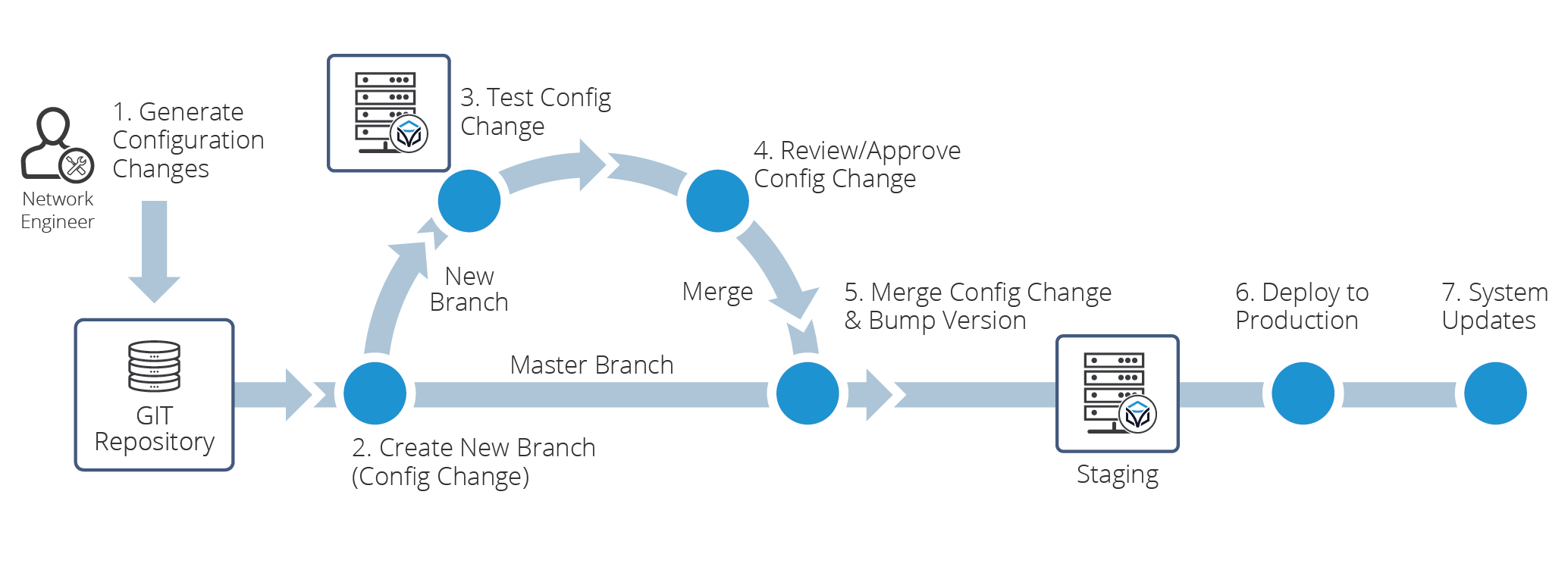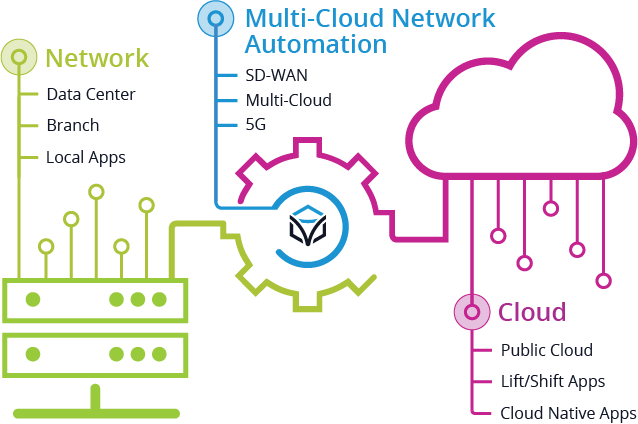
Overview
- SD-WAN is driving a multi-domain, multi-controller environment.
- Multi-cloud is the reality for most enterprises, including the adoption of SaaS-based enterprise software platforms.
- Connecting multiple types of users, on multiple types of devices, to multiple cloud environments is complex and challenging.
- Treating the network as a separate ‘silo’ will not harvest the full benefits of an automation strategy.
- Itential powers end-to-end network automation for enterprises and service providers.
As the demand for internet connectivity exponentially rises along with increasing adoption of cloud applications, traditional wide area network (WAN) architectures fail to deliver the expected application experience, optimize cloud connectivity, improve security, and provide complete visibility of the network to manage devices and resolve network issues. Recent innovation in the networking domain is due in part to a market shift from “speeds and feeds,” to one focused on innovative services and a programmable network. SD-WAN is evolving and enabling the acceleration for more innovative services, by extending SD-WAN into a multi-cloud reality with enhanced security and analytics, while connecting innovation at the edge with application and cloud concepts. While we have seen tremendous innovation in the cloud ecosystems, other domains are adopting similar concepts to create software-centric, programmable networks.

The Origin of SD-WAN
Wide Area Network (WAN) has widely been used to connect branch users to applications hosted in data centers using dedicated MPLS circuits that ensure predictable connectivity and security. But as more enterprises started adopting SaaS/IaaS applications, WANs couldn’t handle the exponential traffic growth in multiple clouds causing network management, application performance and compliance issues.
We have witnessed the public cloud explode and create platforms that have unlocked innovation in the application domain. SD-WAN was originally touted as a way to leverage both private (MPLS) and public (internet) networks to route traffic to the most appropriate network. Given these applications and networks now span multiple cloud platforms, data centers, WANs, LANs, and edge, we should view the automation of networks as a multi-domain problem. Each domain will have unique challenges which should be automated locally while providing an end-to-end capability to align with the target network reality.
SD-WAN provides such benefits as:
Optimal User Experience
Dynamic bandwidth management delivers optimal user experience by improving business application performance and increasing agility for SaaS and other cloud applications.
Simplified Network Management
Easily scale to manage thousands of devices across your entire network and execute zero-touch deployment automations through cloud-based management using a single interface.
Enhanced Security
Enforce real-time security policies for different locations, users, applications, and devices on the network for a more robust and distributed security strategy.
Reduced Costs
Optimize bandwidth/resource usage for multi-domain solutions to reduce operational costs by dynamically routing application traffic to drive efficient delivery.
The explosion in the demand for new cloud-based services, applications, and networks spans across various domains such as distributed clouds, data centers, WANs, LANs, and edge. This has resulted in the expectation for SD-WAN services to traverse multiple domains or face failures to deliver the expected application experience, optimize cloud connectivity, improve security, and to provide complete visibility of the network for managing and resolving network issues.
A lack of interoperability across distributed multi-domain networks leads to siloed operations, complex platform interactions, and ultimately higher operational costs. This is placing an increased burden on already stretched network operations teams to not only maintain business as usual services running, but rollout new technologies, such as SD-WAN branches. NetOps teams are now expected to manage multiple vertical solutions across multiple domains, which also comes with a steep learning curve.
Whilst SD-WAN lends itself to more software orientated development and deployment strategies, this opens up new challenges around training network engineers in these new fields. Without an automation solution that can abstract the complexities of these modern technologies, it would be a tall order for NetOps teams within organizations to pursue automation without re-tooling and re-development.


Connecting the Silos with Hybrid Cloud Network Automation
SD-WAN and multi-cloud solutions must include a multi-domain strategy to provide coordinated service creation as well as basic operations and configuration management capabilities. Traditional network management concepts are relegated to siloed strategies with organizational and technical solutions for each domain. Given modern services are distributed across a complex networking environment, network automation strategies need to focus on integrating these multiple domains under a comprehensive, end-to-end automation platform that hides the complexity of networking, converges technology siloes, and deploys programmable infrastructure.
While SD-WAN is the future, companies need to keep their existing networks running. In most cases, SD-WAN is being adopted in brownfield deployments, and most companies don’t have the luxury of ‘ripping-and-replacing’ whole networks, so they need to find a way to manage their existing networks in a programmable way. Enterprises and service providers need a modern solution to manage SD-WAN deployments and execute end-to-end multi-domain network automations.

![]()
Network automation is the key to enabling organizations to transition and manage legacy networks in combination with next-generation technologies, like SD-WAN using a single toolset, while providing agility and flexibility that allows for collaboration across IT and networking teams.
![]()

Why Automation for SD-WAN Deployments & Management
Enterprises need to look at leveraging automation for multi-domain, multi-vendor systems involved in the entire SD-WAN deployment process. Implementation of fallout feedback loops and expansion of active participation to IT and operations teams will increase rate of change and minimize human errors. The right automation solution can provide value to the initial activation and ongoing day-to-day management of SD-WAN such as:
- Deploy more SD-WAN sites in a single maintenance window.
- Automate all SD-WAN changes at scale, mitigating human errors.
- Ensure SD-WAN configurations are always in compliance to evolving security standards.
Itential network automation enables network teams to move beyond siloed network segments to a holistic view of your entire network where automations and policies can be applied throughout, and devices/resources can be managed in real-time.

Itential Powers End-to-End Network Automation in SD-WAN Deployments
Itential simplifies and automates the management and configuration processes for SD-WAN, enabling organizations to drastically reduce risks and improve efficiency, increase agility, launch applications faster and drive overall business value. Itential supports a wide range of southbound options for interacting with the network and SD-WAN systems, including CloudGenix, Versa, Cisco Meraki, Cisco Viptela, FlexiWAN, Silver Peak, VeloCloud, and others; allowing users to automate even the most complex multi-vendor SD-WAN environments. Users can gain greater velocity for their SD-WAN deployments and operations by leveraging the capabilities of Itential’s automation solution such as:
Streamline SD-WAN Deployment
Automate the end-to-end process for SD-WAN deployment to integrate with any source of truth, ITSM, and network system to eliminate manual steps which cause delays and prevent teams from deploying sites quickly.
Simplify Day-to-Day Management
![]()
Build network automations that can open and update tickets, make network changes, ensure network function, and close tickets that reduce daily backlog due to manual changes.
Ensure Configuration Standardization & Compliance
Build Golden Configuration templates to define a configuration standard that can be used with an API integration to ensure that SD-WAN devices are always in compliance.
Learn More
Automate Pre- & Post-Checks
![]()
Ensure network status checks prior to making any device changes by inspecting the operational state of live network devices and conduct post change evaluations to make sure device changes took effect as intended.
Learn More
Integrate with any IT System
Integrate operational processes and connect your entire IT ecosystem such as ticketing, change management, inventory, and monitoring tools with Itential’s library of open integrations to 100+ systems.
Learn More
Start Fast with Pre-Built Automations for SD-WAN Use Cases
![]()
Get started Itential’s Pre-Built Automations for SD-WAN deployment, change, and compliance use cases.
Explore Pre-Built Library
Automate Across Multi-Domain Networks
Itential mitigates the complexity of managing multiple network types and vendors by consuming and federating the systems and networks managed by those systems, abstracting the complexity from the user for simplified automation.
Use the Right Tool for the Right Job
![]()
Itential enables network engineers to maintain business while leveraging their existing technology investments, while also embracing the next-generation tools as well. By being controller and orchestrator agnostic, Itential enables organizations to future proof their investment.
